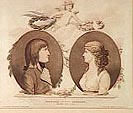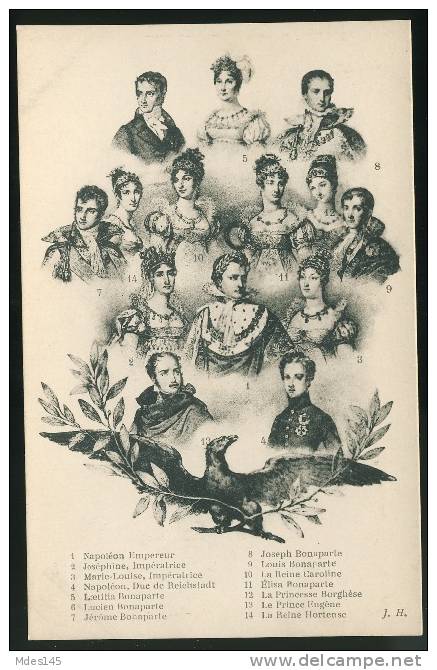To see the rest of our day you can click here.
This afternoon, we dock at Conflans - Conflans-Sainte-Honorine is 24 km from Paris —and we have a choice of tours: either join our guided excursion to AUVERS-SUR-OISE, the quaint little town where Vincent Van Gogh lived and died, or Napoleon and Josephine’s CHÂTEAU de MALMAISON just outside Paris. Requiring extensive renovations, this large country estate was purchased by Josephine Bonaparte in 1799 while Napoleon was fighting in Egypt. It was her aim to make it “the most beautiful and curious garden in Europe, a model of good cultivation.”

Portrait of Bonaparte and Josephine © RMN
We chose Chateau de Malmaison as I'm not a fan of Van Gogh and also I have a big interest in anything Napoleon.
The path which leads to the entrance, with its porch in the form of a military tent, provides a sumptuous sight. Château Malmaison is fascinating for many reasons, notably its interior harmony and the quality of the museum collections, but it is also remarkable also for the moving atmosphere it radiates: here, more than anywhere else, the presence of Bonaparte and Josephine is still perceptible.
The name of Malmaison dates back to the existence of a hideout used by Norman invaders as their base for carrying out raids on the surrounding region. The first mention of this “Mala domus” (evil house) in texts was in 1244. A manor house is referred to in the 14th Century under the name of La Malmaison (the evil house).
Josephine used swans in a lot of her decorating.
The Revolution led the current owner Jacques-Jean Le Couteulx, a rich banker, to part with Malmaison, which they sold to Joséphine Bonaparte on 21 April 1799 for the sum of FF 325,000. This purchase was approved by Bonaparte on his return from Egypt, whereupon he became the true owner of the estate.
My favourite painting Napoleon Crossing the Alps. The original painting remained in Madrid until 1812, when it was taken by Joseph Bonaparte after his abdication as King of Spain. He took it with him when he went into exile in the United States, and it hung at his "Point Breeze" estate near Bordentown, New Jersey. The painting was handed down through his descendants until 1949, when his great grandniece, Eugenie Bonaparte, bequeathed it to the museum of the Château de Malmaison.
There are five versions of this painting by David.
In reality the crossing had been made in fine weather and Bonaparte had been led across, mounted on a mule, by a guide; however, from the outset the painting was first and foremost propaganda, and Bonaparte asked David to portray him "calm, mounted on a fiery steed" (Calme sur un cheval fougueux), and it is probable that he also suggested the addition of the names of the other great generals who had led their forces across the Alps: Hannibal and Charlemagne (as Karolus Magnus).
Josephine used swans in a lot of her decorating.
The Revolution led the current owner Jacques-Jean Le Couteulx, a rich banker, to part with Malmaison, which they sold to Joséphine Bonaparte on 21 April 1799 for the sum of FF 325,000. This purchase was approved by Bonaparte on his return from Egypt, whereupon he became the true owner of the estate.
My favourite painting Napoleon Crossing the Alps. The original painting remained in Madrid until 1812, when it was taken by Joseph Bonaparte after his abdication as King of Spain. He took it with him when he went into exile in the United States, and it hung at his "Point Breeze" estate near Bordentown, New Jersey. The painting was handed down through his descendants until 1949, when his great grandniece, Eugenie Bonaparte, bequeathed it to the museum of the Château de Malmaison.
There are five versions of this painting by David.
In reality the crossing had been made in fine weather and Bonaparte had been led across, mounted on a mule, by a guide; however, from the outset the painting was first and foremost propaganda, and Bonaparte asked David to portray him "calm, mounted on a fiery steed" (Calme sur un cheval fougueux), and it is probable that he also suggested the addition of the names of the other great generals who had led their forces across the Alps: Hannibal and Charlemagne (as Karolus Magnus).
On the breastplate yoke of the horse, the picture is signed and dated by David.
After their divorce in 1809, the Emperor gave her this property together with its collections, and it was here that she died on 29 May 1814. Her son, Prince Eugène, inherited the property but his widow sold Malmaison to the Swedish banker Jonas Hagerman in 1828.
In 1842, Queen Christine of Spain, the widow of King Ferdinand VII, acquired the castle as a place of residence, then in 1861 sold it back to Napoléon III, Joséphine’s grandson. Damaged by fighting during the war of 1870, then by the installation of barracks in the castle, the estate was sold by the State in 1877 to a goods merchant who progressively sold off parcels of land from the park. In 1896, Daniel Iffla, known as Osiris , purchased the castle together with its park, by now reduced to 6 hectares, and donated it to the State in 1904. A museum was inaugurated on the estate in 1906.
In 1842, Queen Christine of Spain, the widow of King Ferdinand VII, acquired the castle as a place of residence, then in 1861 sold it back to Napoléon III, Joséphine’s grandson. Damaged by fighting during the war of 1870, then by the installation of barracks in the castle, the estate was sold by the State in 1877 to a goods merchant who progressively sold off parcels of land from the park. In 1896, Daniel Iffla, known as Osiris , purchased the castle together with its park, by now reduced to 6 hectares, and donated it to the State in 1904. A museum was inaugurated on the estate in 1906.
After the divorce Joséphine continued to entertain and maintained her former lifestyle in spite of her partial solitude. She held open house and organised concerts in her gallery, sometimes receiving such noted hosts as Tsar Alexander I.
Napoleon was to return to Malmaison only twice after 1809 to visit Joséphine and would stay there one last time from 25-29 June 1815 following his abdication, to dwell on his memories.
The gardens were beautiful.
Napoleon was to return to Malmaison only twice after 1809 to visit Joséphine and would stay there one last time from 25-29 June 1815 following his abdication, to dwell on his memories.
The gardens were beautiful.



.JPG)


.JPG)
.JPG)
.JPG)
.JPG)
.JPG)
.JPG)
.JPG)
.JPG)
.JPG)







.JPG)
.JPG)
.JPG)
.JPG)
.JPG)
.JPG)



But the mind travels far - and mysteriously - in sleep.
ReplyDeleteFlights to Harare
Cheap Flights to Harare
Cheap Air Tickets to Harare